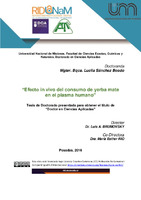Efecto in vivo del consumo de yerba mate en el plasma humano
Abstract
La yerba mate (Ilex paraguariensis Saint Hil.) es una planta consumida en como infusiones frías y calientes, en la forma tradicional de mate caliente posee gran capacidad antioxidante (CAO) debido a su elevado contenido en polifenoles, así como también minerales como Fe y Mg entre otros. Las deficiencias nutricionales de Fe conducen a la anemia ferropénica, siendo los grupos más vulnerables las mujeres en edad fértil y los niños, debido a las pérdidas menstruales y los grandes requerimientos respectivamente. Los objetivos de la primera etapa de este trabajo fueron, determinar la variación de la CAO plasmática, por los métodos FRAP (poder antioxidante de reducir el férrico) y el método de inhibición del radical catión ABTS, luego del consumo de 300 mL de una infusión de YM, y evaluar la biodisponibilidad de los polifenoles totales. En esta etapa se trabajó con 17 voluntarios, los que ingirieron 300 mL de una infusión de YM y 3 voluntarios 300 mL de agua, se les midió CAO plasmática, polifenoles totales, uricemia y proteinemia a los tiempos 0 (inicial), 20, 40, 60, 80, 100 y 120 minutos posteriores a la ingesta. El objetivo de la
segunda etapa fue cuantificar la biodisponibilidad del Mg de las infusiones de YM, en esta etapa se trabajó con 12 voluntarias, las que consumieron 300 mL de una infusión de YM y se les midió magnesemia a los tiempos 0 (inicial), 20, 40, 60, 80, 100 y 120 minutos posteriores a la ingesta. El objetivo de la tercera etapa fue determinar la biodisponibilidad del Fe de las infusiones de YM y el efecto de los polifenoles sobre la biodisponibilidad el hierro no hemínico consumido conjuntamente con las infusiones de YM. En esta etapa se trabajó con 10 voluntarias, las que consumieron primeramente 300 mL de una infusión de YM, en una segunda oportunidad 300 mL de una solución conteniendo 40 mg de Fe como sulfato ferroso y en una tercera oportunidad 40 mg de Fe (como sulfato ferroso) disueltos en 300 mL de una infusión de YM. En todos los casos se realizaron extracciones de sangre al tiempo 0 (inicial) y luego a los 20, 40, 60, 80, 100 y 120 minutos y se midió la CAO plasmática y ferremia en todos los tiempos. En la primera etapa se determinó que la biodisponibilidad de los polifenoles de la YM consumida en su forma tradicional de mate caliente cebado durante los primeros 120 minutos fue de 49,3 ± 11,9 %. La ingesta de 300 mL de una infusión de YM produce un aumento de la CAO en plasma medido por método FRAP de 8,3 ± 3,3 % y por el método ABTS 6,0 ± 2,0 %. La CAO plasmática en promedio comenzó a elevarse a los 20 minutos y se mantuvo elevada hasta los 120 minutos que duró la experiencia. La ingesta de infusiones de yerba mate no produce incremento de la uricemia ni proteinemia plasmática durante las dos horas que duró la prueba. Se determinó que 300 ml de infusiones de YM contienen un promedio de 3,1 ± 1,2 mg de Mg, 376 ± 21 μg de Fe y 1,41 ± 0,16 mg de EAG de polifenoles. Se comprobó que existe una variación en la composición de las infusiones de yerba mate, siendo del 49 % para el Mg y del 23 % para el Fe. Se comprobó que la biodisponibilidad del Mg proveniente de Infusiones de YM preparadas en su forma tradicional de mate caliente, fue en promedio de 3,1 ± 1,2 mg de Mg. Se observa una gran variabilidad interindividual en la dinámica de absorción. Si bien 300 mL de infusiones de YM contienen en promedio el 25 % de la Ingesta Diaria Recomendada (IDR) de Mg, sólo se llega a absorber el 1 % de la IDR. En la tercera etapa se determinó que durante las dos horas que dura la prueba se absorbió en promedio el 44,6 ± 18,4 % del hierro ingerido en los 300 mL de la infusión de yerba mate. Se comprobó que de los 40 mg de hierro ingerido en forma de sulfato ferroso se absorbió en promedio un 8,3 ± 6,1 % de la ingesta total y que cuando se consumió conjuntamente con una infusión de yerba mate su absorción promedio descendió a 2,0 ± 1,3 % de la ingesta inicial. Debido a esto se concluye que las infusiones de yerba mate inhiben la absorción del Fe (como sulfato ferroso) en promedio un 73,2 ± 10 %. Se observa una gran variabilidad interindividual en lo que respecta a la dinámica de absorción de Fe no hemínico. Conociendo la prevalencia de la anemia por deficiencia de hierro en las mujeres en edad fértil y el efecto inhibitorio sobre la absorción del Fe por parte de los polifenoles de las infusiones de yerba mate caliente, es importante aconsejar su consumo alejado de las comidas, como también el de las infusiones de té y café. Se determinó que el consumo de 40 mg de Fe como FeSO4 produce un aumento de la CAO plasmática medida por el FRAP de 2,6 % y por el ABTS de 6,2 %. No se observó diferencia estadísticamente significativa entre la CAO plasmática de las voluntarias que consumieron la infusión de YM y las que consumieron conjuntamente la infusión de YM con los 40 mg de Fe. El aumento de la CAO plasmática debido al consumo de los polifenoles de las infusiones de YM podrían reforzar las defensas antioxidantes previniendo el daño oxidativo causante de muchas enfermedades crónicas. Por otro lado, conociendo la prevalencia de la anemia por deficiencia de hierro en las mujeres en edad fértil y el efecto inhibitorio sobre la absorción del Fe por parte de los polifenoles de las infusiones de yerba mate caliente, es muy importante, en estos casos, aconsejar su consumo alejado de las comidas. Yerba mate (Ilex paraguariensis Saint Hil.) It is a plant consumed in the form of hot and cold infusions, as traditional form hot mate has high antioxidant capacity (AOC) due to its high content in polyphenols, as well as minerals such as Fe and Mg. Nutritional deficiencies of Fe lead to iron deficiency anemia. The most vulnerable groups are women childbearing age and children, due to menstrual losses and large requirements, respectively. The objectives of the first stage of this work were to determine plasma AOC variation by FRAP method (ferric reducing antioxidant power) and ABTS method radical cation inhibition method, after the consumption of 300 mL of YM infusion, and evaluate the total polyphenols bioavailability. At this stage, 17 volunteers were used, 300 mL of an infusion of YM and 3 volunteers 300 mL of water were measured. Plasma AOC, total polyphenols, plasma uric and plasma protein were measured at 0 (initial), 20, 40, 60, 80, 100 and 120 minutes after ingestion. The objective of the second stage was to quantify the Mg bioavailability of YM infusions, in this stage we worked with 12 volunteers, who consumed 300 mL of an YM infusion and was measured plasma magnesium at 0 (initial) times, 20, 40, 60, 80, 100 and 120 minutes after ingestion. The objective of the third stage was determined bioavailability of Fe from YM infusions and the effect of polyphenols on the bioavailability of non-hemiconic iron consumed along with YM infusions. At this stage we worked with 10 volunteers, who first consumed 300 mL of a YM infusion, in a second opportunity 300 mL of a solution containing 40 mg of Fe as ferrous sulfate and in a third opportunity 40 mg of Fe (as sulfate Ferrous) dissolved in 300 mL of a YM infusión. In all cases blood extractions were performed at time 0 (initial) and after 20, 40, 60, 80, 100 and 120 minutes and plasma AOC and plasma iron were measured at all times. In the first stage it was determined polyphenols bioavailability of YM infusions consumed as traditional hot maté primed during the first 120 minutes was of 49.3 ± 11.9 %. Intake of 300 mL of YM infusion leads to an increase in plasma AOC by FRAP method to 8.3 ± 3.3 % and by ABTS method to 6.0 ± 2.0 %. The plasma AOC on average began to rise at 20 minutes and was maintained until the 120 minutes that lasted experience. Intake of YM infusions does not increase plasma uricemia or plasma protein during two hours test. In the second stage, it was determined that, during the two hours test, an average of 6.1 ± 7.1 % (3.9 mg) of the magnesium ingested (77.9 ± 29.1 mg) was absorbed in the 300 mL YM infusion of. It was determined that 300 ml of YM infusions contain an average of 3.1 ± 1.2 mg of Mg, 376 ± 21 μg of Fe and 1.41 ± 0.16 mg of EAG of polyphenols. It was found that there is a variation in the composition of yerba mate infusions, being 49% for Mg and 23% for Fe. It was found that the bioavailability of Mg from YM infusions prepared in its traditional form of mate hot, is on average 3.1 ± 1.2 mg Mg. The Mg bioavailability in YM infusions of is greatly reduced compared to that in solid foods or milk. There is a large interindividual variability in the dynamics absorption. Although 300 mL of YM infusions contain on average 25 % of the Mg Recommended Daily Intake (RDI), only one absorber reaches 1.26 of the RDI. In the third stage, it was determined that during the two hours test lasted, an average of 44.6 ± 18.4 % of the ingested iron in the 300 ml of YM infusion was absorbed, constituting approximately 1 % of RDI For a woman of childbearing age and with a high bioavailability diet of 15%. It was verified that of the 40 mg of iron as ferrous sulfate an average of 8.3 ± 6.1 % of total intake was absorbed and that when it was consumed in conjunction with a YM infusion its average absorption fell to 2,0 ± 1.3 % of the initial intake. Because that, it is concluded YM infusions inhibit the Fe absorption (as ferrous sulphate) by an average of 76 %. There is a large interindividual variability with respect to non-heminic Fe absorption dynamics. Knowing the anemia prevalence due iron deficiency in childbearing age women and the inhibitory effect on the Fe absorption by hot YM infusions polyphenols, it is important to advise their consumption away from meals as well as tea and coffe infusions. It was determined that consumption of 40 mg of Fe as SO4Fe produced an increase in the plasma CAO measured by FRAP of 2.6 % and by the ABTS of 6.2 %. There was no statistically significant difference between plasma AOC of volunteers who consumed YM infusion and those who consumed YM infusion together with the 40 mg of Fe. The increase in plasma AOC due to the consumption of the polyphenols from YM infusions could strengthen the antioxidant defenses preventing the oxidative damage that causes many chronic diseases. On the other hand, knowing the prevalence of iron deficiency anemia in women of childbearing age and the inhibitory effect on Fe absorption by YM infusions containing polyphenols, it is very important in these case, advise your consumption away from meals.
Collections
- Doctorado [62]
The following license files are associated with this item:




